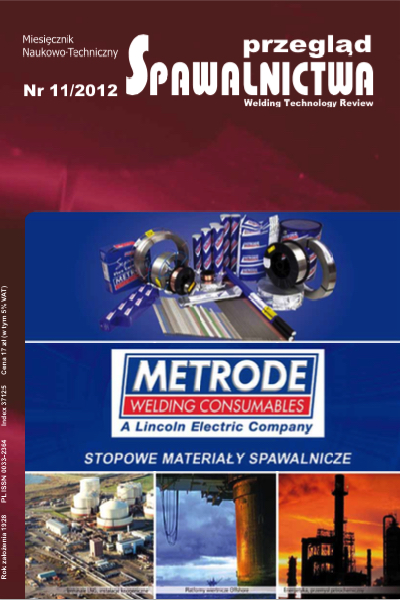Analiza parametrów spawania GMA metodą wykrywania zakłóceń procesu spawania
Main Article Content
Abstract
Przedstawiono metodę opracowania wyników monitorowania procesu spawania GMA umożliwiającą lokalizację zakłóceń procesu spawania. Jako zakłócenie zastosowano warstwę farby na powierzchni rowka spawalniczego, której produkty spalania w łuku spawalniczym mogą spowodować powstanie niezgodności typu pustka gazowa. W czasie spawania rejestrowano parametry spawania i badano wpływ wprowadzonego zakłócenia na spadek napięcia łuku i wartość natężenia prądu w metodzie GMA. Badano cechy statystyczne rejestrowanych sygnałów i wykazano, że wartość wariancji parametrów spawania obliczana w próbkach może być wykorzystana do lokalizacji obszarów, w których występują zakłócenia. możliwa jest także ocena stopnia nasilenia wprowadzonego zakłócenia. Uzyskane wyniki porównano z kartami rozstępu Shewharta.
Analyze of GMA welding parameters as a method of weld disturbance detection
A method of location of the GMA welding process disturbance by analyzing the results of monitoring of welding parameters was presented. A layer of paint on the surface of welding groove was used as a disturbance. This kind of disturbance can produce gas voids in the weld. The influence of applied disturbance on arc voltage and welding current was examined. Statistical features of recorded welding current and voltage were tested and it was proved that value of variance of welding parameters calculated in samples can be used to locate area where disturbance was introduced. The estimation of disturbance intensity can also be explored. Results were compared with Shewharts statistical quality control carts.
Downloads
Article Details
Creative Commons CC BY 4.0 https://creativecommons.org/licenses/by/4.0/
Welding Technology Review (WTR) articles are published open access under a CC BY licence (Creative Commons Attribution 4.0 International licence). The CC BY licence is the most open licence available and considered the industry 'gold standard' for open access; it is also preferred by many funders. This licence allows readers to copy and redistribute the material in any medium or format, and to alter, transform, or build upon the material, including for commercial use, providing the original author is credited.
References
Blakeley P.: Who should be using arc monitoring. Welding and metal Fabrication 1990, no. 5, s. 268-272.
PN-ISO 8258:1996 + AC1 Karty kontrolne Shewharta.
Adolfson S., Bahrami A., Blomsjo G., Claesson I.: On-Line Quality monitoring In Short-Circuit Gas metal Arc Welding. Welding Journal, 1999. no 2, s. 59-73s.
Quinn T.P., Smith C., mc Cowan C.n.: Arc Sensing for Defects
in Constant-Voltage Gas metal Arc Welding. Welding Journal,
, no 9, s. 322-328.
Wu C.S., Polte T., Rehfeldt D.: A Fuzzy Logic System for Process monitoring and Quality Evaluation in GmAW. Welding Journal, 2001, no. 2, s. 33-37.
Dilthey U., Hichri H.: Structure of a monitoring and control system for the on-line checking of GmA welding processes on the basis of a neuro-fuzzy architecture. Welding and Cutting, 2003, no. 6, s. 316-321.
Luksa K.: Influence of weld imperfection on short circuit GMA welding arc stability. Journal of materials Processing Technology, 2006, vol. 175, no 1/3, s. 285-290.
http://www.somar.com.pl/oferta/monitorowanie procesow spawania
